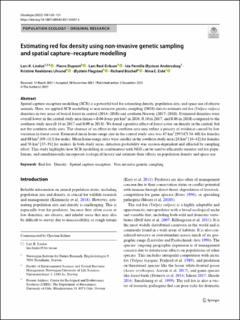| dc.contributor.author | Lindsø, Lars | |
| dc.contributor.author | Dupont, Pierre | |
| dc.contributor.author | Rød-Eriksen, Lars | |
| dc.contributor.author | Andersskog, Ida Pernille Øystese | |
| dc.contributor.author | Ulvund, Kristine R. | |
| dc.contributor.author | Flagstad, Øystein | |
| dc.contributor.author | Bischof, Richard | |
| dc.contributor.author | Eide, Nina Elisabeth | |
| dc.date.accessioned | 2022-03-31T08:31:43Z | |
| dc.date.available | 2022-03-31T08:31:43Z | |
| dc.date.created | 2021-12-16T12:02:11Z | |
| dc.date.issued | 2021 | |
| dc.identifier.citation | Oecologia. 2021, 198 139-151. | |
| dc.identifier.issn | 0029-8549 | |
| dc.identifier.uri | https://hdl.handle.net/11250/2988739 | |
| dc.description.abstract | Spatial capture–recapture modelling (SCR) is a powerful tool for estimating density, population size, and space use of elusive animals. Here, we applied SCR modelling to non-invasive genetic sampling (NGS) data to estimate red fox (Vulpes vulpes) densities in two areas of boreal forest in central (2016–2018) and southern Norway (2017–2018). Estimated densities were overall lower in the central study area (mean=0.04 foxes per km2 in 2016, 0.10 in 2017, and 0.06 in 2018) compared to the southern study area (0.16 in 2017 and 0.09 in 2018). We found a positive efect of forest cover on density in the central, but not the southern study area. The absence of an efect in the southern area may refect a paucity of evidence caused by low variation in forest cover. Estimated mean home-range size in the central study area was 45 km2 [95%CI 34–60] for females and 88 km2 [69–113] for males. Mean home-range sizes were smaller in the southern study area (26 km2 [16–42] for females and 56 km2 [35–91] for males). In both study areas, detection probability was session-dependent and afected by sampling efort. This study highlights how SCR modelling in combination with NGS can be used to efciently monitor red fox populations, and simultaneously incorporate ecological factors and estimate their efects on population density and space use. Red fox · Density · Spatial capture–recapture · Non-invasive genetic sampling | |
| dc.language.iso | eng | |
| dc.title | Estimating red fox density using non-invasive genetic sampling and spatial capture–recapture modelling | |
| dc.type | Peer reviewed | |
| dc.type | Journal article | |
| dc.description.version | publishedVersion | |
| dc.subject.nsi | VDP::Basale biofag: 470 | |
| dc.subject.nsi | VDP::Basic biosciences: 470 | |
| dc.subject.nsi | VDP::Basale biofag: 470 | |
| dc.subject.nsi | VDP::Basic biosciences: 470 | |
| dc.source.pagenumber | 139-151 | |
| dc.source.volume | 198 | |
| dc.source.journal | Oecologia | |
| dc.identifier.doi | 10.1007/s00442-021-05087-3 | |
| dc.identifier.cristin | 1969385 | |
| dc.relation.project | Norges forskningsråd: 244557 | |
| dc.relation.project | Miljødirektoratet: 18S247E2 | |
| dc.relation.project | Norges forskningsråd: Wildmap: 286886 | |
| cristin.ispublished | true | |
| cristin.fulltext | original | |
| cristin.qualitycode | 2 | |
